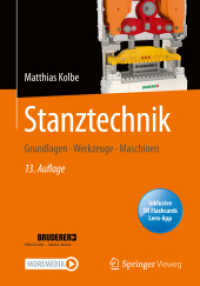- ホーム
- > 洋書
- > 英文書
- > Science / Mathematics
基本説明
植物生化学に関して、基本知識から多様な商業用途まで学ぶことができる人気テキスト、6年振りの改訂版。光合成、遺伝子工学、多糖類代謝、脂質代謝など、植物の生理・生化学から分子生物学までを幅広く収録。第2版邦訳『植物生化学』シュプリンガー・フェアラーク東京・2000年出版。
This fully revised translation of the world-renowned German edition covers the complete and modern knowledge of plant biochemistry. The book presents the topic in a concise and simplified manner so that students can digest the message and gain a basic knowledge of the entire field of plant biochemistry, from photosynthesis (the synthesis of natural plant products) to all kinds of genetic engineering with its many commercial applications. Topics include cell structure and function, lipid and polysaccharide metabolism, nitrogen fixation, phloem transport, synthesis and function of isoprenoids, phenylpropanoids and other secondary metabolites, plant growth regulation and development. Heldt provides a comprehensive description of photosynthesis, primary and secondary metabolism, the function of phytohormones and molecular engineering. The text covers research findings until the end of 2003 and identifies areas of future research. There are extensive references to the most recent scientific literature.
Full Description
The fully revised and expanded fourth edition of Plant Biochemistry presents the latest science on the molecular mechanisms of plant life. The book not only covers the basic principles of plant biology, such as photosynthesis, primary and secondary metabolism, the function of phytohormones, plant genetics, and plant biotechnology, but it also addresses the various commercial applications of plant biochemistry. Plant biochemistry is not only an important field of basic science explaining the molecular function of a plant, but is also an applied science that is in the position to contribute to the solution of agricultural and pharmaceutical problems.Plants are the source of important industrial raw material such as fat and starch but they are also the basis for the production of pharmaceutics. It is expected that in the future, gene technology will lead to the extensive use of plants as a means of producing sustainable raw material for industrial purposes. As such, the techniques and use of genetic engineering to improve crop plants and to provide sustainable raw materials for the chemical and pharmaceutical industries are described in this edition. The latest research findings have been included, and areas of future research are identified.
Contents
1. A Leaf Cell Consists of Several Metabolic Compartments2. The Use of Energy from Sunlight by Photosynthesis is the Basis of Life on Earth 3. Photosynthesis is an Electron Transport Process 4. ATP is Generated by Photosynthesis 5. Mitochondria are the Power Station of the Cell 6. The Calvin Cycle Catalyzes Photosynthetic CO2 Assimilation 7. In the Photorespiratory Pathway Phosphoglycolate Formed by the Oxygenase Activity of RubisCo is Recycled 8. Photosynthesis Implies the Consumption of Water9. Polysaccharides are Storage and Transport Forms of Carbohydrates Produced by Photosynthesis 10. Nitrate Assimilation is Essential for the Synthesis of Organic Matter 11. Nitrogen Fixation Enables the Nitrogen in the Air to be Used for Plant Growth 12. Sulfate Assimilation Enables the Synthesis of Sulfur Containing Substances 13. Phloem Transport Distributes Photoassimilates to the Various Sites of Consumption and Storage14. Products of Nitrate Assimilation are Deposited in Plants as Storage Proteins 15. Glycerolipids are Membrane Constituents and Function as Carbon Stores 16. Secondary Metabolites Fulfill Specific Ecological Functions in Plants17. Large Diversity of Isoprenoids has Multiple Funtions in Plant Metabolism18. Phenylpropanoids Comprise a Multitude of Plant Secondary Metabolites and Cell Wall Components 19. Multiple Signals Regulate the Growth and Development of Plant Organs and Enable Their Adaptation to Environmental Conditions20. A Plant Cell has Three Different Genomes 21. Protein Biosynthesis Occurs at Different Sites of a Cell 22. Gene Technology Makes it Possible to Alter Plants to Meet Requirements of Agriculture, Nutrition, and Industry






